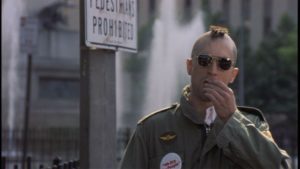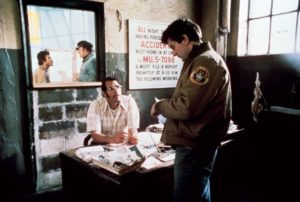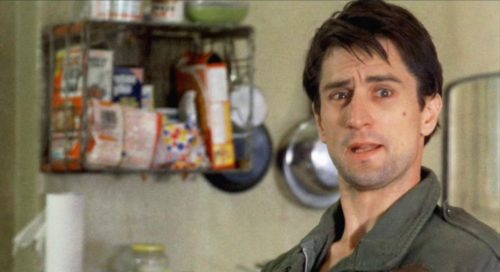Besides being a masterpiece, Taxi Driver endures in part because the conditions that inspired it endure.
Not many critics would name it as the best American movie, and it probably would rank as few fans’ favorite films. Is Taxi Driver, nevertheless, the most important American film? It is, in the sense that we need our best art to endure; to speak past trends and time, to tell us about ourselves while asking more questions than are answered (otherwise it’s philosophy or worse, literary theory).
Shakespeare’s oft-quoted notion of stories holding a mirror up to Nature has become a crutch if not cliché for describing what art does. As history continues to confirm that we’ve evolved less than we might hope or imagine in the intervening centuries since Hamlet soliloquized, the more relevant issue might be why art matters. As such, it’s probably Oscar Wilde who got it right when he declared “It’s the spectator, and not life, that art really mirrors.”
Taxi Driver might not even be Scorsese’s best movie, but it’s definitely in the Top One. Okay, Raging Bull could fairly be considered his ultimate achievement (although substantial credit must be given to the ready-made script and tag-team for the ages from De Niro and Pesci). Mean Streets may, for aficionados, be his most consistently watchable (aside from The Departed, but in terms of aesthetic heft, that comparison would be like an all-star game vs. what the Miracle Mets pulled off in ’69—de rigueur brilliance vs. once-in-a-lifetime lightning caught in a bottle of straw-covered Chianti). Goodfellas, of course, is Goodfellas.
Aside from Taxi Driver, is there a film that continues to address—both directly and indirectly—so much of what makes America simmer and sometimes explode? Network turned out to be so prescient it’s practically a documentary (and would this make Paddy Chayefsky cackle or cry?). Taxi Driver seems to provide both a macro and micro analysis of our combustible American experiment: violence, sex, repression, isolation, exploitation, poverty (for starters) and the ways these phenomenon push and pull on practically everyone, occasionally proving toxic for the least-equipped amongst us.
Two words: Bernard Herrman. Three words: Best Soundtrack Ever.
In the crowded field of contenders, a handful of geniuses easily distance themselves from the competition: Piero Umiliani is Bach, Nino Rota is Mozart, John Barry is Wagner, (John Williams is Stephen King), and Bernard Herrmann is Beethoven. (Ennio Morricone is God.)
There’s also Beethoven-level pathos in the fact that not only was this Herrmann’s final score, but he died literally hours after completing it. Added bonus: as Scorsese was largely unknown during pre-production, the notoriously cantankerous Herrmann was unmoved by the director’s desire to have him score the film. “I don’t write music for car movies,” he allegedly said. Only when he saw the scene where Travis pours peach brandy over his breakfast was he convinced.
Fact: during the immortal “You talkin’ to me?” scene, the screenplay simply read “Travis looks in the mirror.” (A reminder that not only was De Niro once an actor, during his prime there were few better.)
Apparently Scorsese first approached Dustin Hoffman to play Travis Bickle. It’s best to not even imagine how different this movie would have been.
Many other actors were considered for (even offered) the part, ranging from the intriguing (Jeff Bridges) to the preposterous (Burt Reynolds?!).
The fact that Paul Schrader spent some time sleeping in a car before writing the screenplay helps offer insight into the myriad ways everything about Taxi Driver feels so real.
In an interview, Albert Brooks relates the conversation (equal parts amusing and disturbing) where, after filming, Schrader thanked him for helping him “understand” Tom, the one character he didn’t understand.
The stories of method actors being method actors can be hilarious and embarrassing, but at times, instructive. It may seem obvious or facile, but the time De Niro took actually driving a cab around NYC enriches his performance. Just the way he stretches his sore neck after another endless evening is a deft, if subtle touch. It’s also a natural reaction from someone who has pulled some 15 hour shifts.
We rightly mock the onanism of thespians who believe staying in character throughout a shoot confers authenticity. How many actors, today, fresh off an Academy Award—as De Niro was in ’74—would actually spend any (much less substantial) time physically driving a cab?
Also noteworthy is the way De Niro, the ultimate New Yorker, is able to convincingly seem out of his element (on all levels) in The Big Apple. He supposedly studied the speech patterns of some soldiers from the Midwest (while on the set of Bertolucci’s 1900).
The issue of Bickle’s “complicated” views on racial relations is a subtle (and sometimes not-so-subtle) theme that recurs. In the original screenplay, the pimp (Harvey Keitel) and both the Mafioso and bodyguard/bouncer were all black. Consider that, and appreciate the credit Scorsese deserves for his better judgment—creative and cultural—in spite of screenwriter Paul Schrader’s objections.
No matter how controversial his treatment of race, in this or any movie, it’s impossible to pretend Scorsese is not rendering real people, however backward or repellant. Contrast this with another director who courts derisive scandal, Quentin Tarantino, whose characters’ bigotry always seems too gleeful by half. Where Scorsese, at his most incendiary, can credibly claim he’s interrogating certain experiences and observations of an adult with the filth of a city under his fingernails, Tarantino repeatedly comes off like a developmentally arrested video clerk who has lived his life watching movies.
According to legend, the actor intended to play the role of Bickle’s psychotic passenger (George Memmoli, memorable as Joey from Mean Streets) was injured and couldn’t make the shoot. Scorsese gamely stepped in and gave it a shot. Suffice it to say, the results are terrifying, and astonishing. The entire film holds a camera up to NYC’s shadiest back-alleys, and this scene depicts the rotten core inside these hearts of darkness as much as any of the more celebrated ones.
It’s fascinating to hear Scorsese (in interviews and the making-of feature) describing the way De Niro directed him during their scene together.
While so many other scenes continue to be discussed and celebrated, with good reason, De Niro nevertheless gives a clinic even as the camera mostly focuses on Scorsese. His economy of words and movement in this scene are extraordinary: for almost four whole minutes, the only thing Bickle says is “Yeah,” twice.
The best soundtrack scores contain music that can exist entirely outside the films they appear in (or were written for), yet are—for all the right reasons—inseparable from the movies themselves.
Perhaps more than any film, Taxi Driver portrays New York City as it used to be (for better and worse). Adding to an already claustrophobic script, the shoot occurred during a garbage strike over the course of an unusually sweltering summer. One can certainly see, and practically smell the mid-decade grime.
For visual evidence of how much the city has actually changed, this site does some wonderful work.
No matter how many times you’ve seen it—and you know it’s coming—the slow pan-up revealing Bickle’s Mohawk remains one of the more arresting, and disturbing visuals in all cinema.

The aforementioned improvisation before the mirror is venerated as one of De Niro’s finest moments. For this writer, the unbearable moments that occur as Travis follows Betsy out of the porn movie might best illuminate De Niro’s mastery of craft. Even as his date (and we) cringe that he’s naïve enough to even consider a “dirty movie” (in Betsy’s words) appropriate, the fact that in this scene—and for large chunks of the movie—we feel empathy for Travis, a character we might understandably feel nothing but disgust for, is one of the primary reasons the movie resonates after repeated viewings.
A great many things occur throughout the course of the film, but few of them happen quickly. The languid pace of the action, obviously, reflects the tensions simmering below the surface. It’s possible that Scorsese’s directorial instincts were never quite as impeccable as they are in Taxi Driver. For instance, this: a scene so pitiful even the camera looks away.
Or this. The implication that Travis is rehearsing his own soliloquy (Hamlet meets the narrator from Dosteyevsky’s Notes from Underground), editing and perfecting it, in his mind.
Okay, one more. If I were forced to submit the single scene (in any movie) that best illustrates both loneliness and alienation, and the ironic disparity between what gets sold on TV (as normal, as achievable, as happiness) and what so many people actually experience, it would be difficult not to choose this one.
A lot of actresses auditioned for the role of Iris. Like dozens. Jodie Foster allegedly was not the first choice, but it’s difficult to imagine anyone else doing the role similar justice.
Some serious heavyweights auditioned for the role of Betsy. Cybill Shepherd was far from the most talented of the lot, but she did exude the combination of beauty and banality the part required.
It’s a minor role, but it can’t be overstated how crucial Albert Brooks is for providing humor and fleeting relief from the near-suffocating intensity of the screenplay.
Even when it’s well-intended, we have an inclination to mythologize artists, particularly actors. There’s nothing wrong with this, especially if the work warrants our adoration. That said, shrewd preparation is seldom sexy as improvised magic, but it’s often crucial for a convincing performance. Case in point, Harvey Keitel spending time with an actual pimp (and play-acting as a prostitute to really get a sense of the power dynamics at play) unquestionably provided heft and credibility to his uncanny turn as Sport.
Paul Schrader, naturally—and with Scorsese’s full blessing—scoured the streets to find a prostitute he could talk to. The young lady he eventually met not only informed the final script, she appears (as Jodie Foster’s friend) in the film.

In terms of bang for buck, is there a character actor from this era who ended up in more epic films than Joe Spinell? In addition to a brief role in Taxi Driver, he also found his way into both Godfather movies, the first two Rocky movies, as well as Cruising, Nighthawks and Night Shift. He should be buried, with a plaque, beneath the Empire State Building.
How many movies have been as flawlessly cast, from the leads to the most minor characters (think Melio in the convenience store, or even the man attempting to rob him, or the Secret Service agent Travis attempts to impress, and not least, Peter Boyle (!) as Wizard).
As reliable and perceptive as Roger Ebert usually was, his speculation that the post-shootout epilogue is a dream sequence has always seemed remarkably undiscerning. Never mind that Schrader, Scorsese and De Niro all are on record as stating the opposite. Never mind that if Travis, from whose point of view we’ve seen all the action unfold, is dead but still “seeing” it undermines the narrative logic. The carnage, horrific as it is, is still only the second most grotesque aspect of the film. The most appalling incongruity is that Bickle’s viewed as a hero. The movie would already be an unqualified success, but with Travis (who, no sentient viewer should forget, was seconds away from attempting to assassinate a presidential candidate) being lionized by the media, Schrader et al. offer some of the darkest irony in cinema history. More, they anticipated an American media that’s only become more culpable for sanitizing or altogether misreading sensational acts because, naturally, sensationalism sells.
Even the ending isn’t really the end. Courtesy of the extremely ambivalent final shot of Travis seeing (or hearing, or sensing) something, and only catching his own eyes in the rear view mirror, the last image the viewer is left with is that Travis remains tightly wound. As the credits roll, one is left wondering if he might be in the news again, inevitably.
Eternal props to Tom Scott.
Apparently De Niro was on board for a sequel. Thank God for the rain that helped wash that garbage from our screens before it ever got made.
This piece originally appeared in The Weeklings on 9/19/16.

